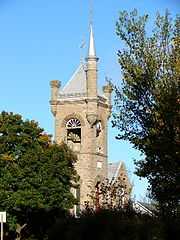Beckwith, Ontario
| Township of Beckwith | |
|---|---|
| Township | |
 | |
| Coordinates: 45°05′N 76°04′W / 45.083°N 76.067°WCoordinates: 45°05′N 76°04′W / 45.083°N 76.067°W | |
| Country |
|
| Province |
|
| County | Lanark |
| Government | |
| • Type | Township |
| • Reeve | Richard Kidd |
| • Governing Body | Beckwith Township Council |
| • MP | Scott Reid (CPC) |
| • MPP | Randy Hillier (OPC) |
| Area[1] | |
| • Total | 240.51 km2 (92.86 sq mi) |
| Population (2011)[1] | |
| • Total | 6,986 |
| • Density | 29.0/km2 (75/sq mi) |
| Time zone | EST (UTC-5) |
| • Summer (DST) | EDT (UTC-4) |
| Area code(s) | 613 |
| Website | www.twp.beckwith.on.ca |
Beckwith is a township in eastern Ontario, Canada, in Lanark County on the Mississippi River. It is located within Canada's National Capital Region.
Communities

The township comprises the communities of 10th Line Shore, Ontario, Black's Corners, Franktown, Franktown Station, Gillies Corners, Hay's Shore, McCann's Shore, Prospect, Rothwell's Shore, Scotch Corners and Tennyson.
Black's Corners, a hamlet south of Carleton Place, is the location for the town hall of Beckwith. This site was chosen in 1857 as a compromise between Franktown and Carleton Place where the township council had met on an alternating basis previously.[2] Currently, there are just a few houses and a store there.
Culture
Franktown promotes itself as the "Lilac Capital of Ontario". It is home to Lilac Lane, which features a beautiful park containing many lilac bushes that have grown there naturally over time, and where a lilac festival is held near the end of May. Within the park facility there is also a baseball diamond.
Also located within Franktown are the Calvary Christian Academy, a private school, and the "Franktown General Store", which features a gas bar, general merchandise, a take-out section (opened in 2007) as well as dry-cleaning services.
Geography
Beckwith was originally covered in deciduous forest, [3] much of which has been cleared for agriculture. Common trees include sugar maple, beech, oak and ash.[4] Trees like hickory and butternut are less common. Wetter areas have elm, silver maple and white cedar. Hemlock was much more common in the past, but logging for bark used in tanning has much depleted this species.[5] The enormous Goodwood Swamp is one of the most important natural areas in the township.[6] There are several different access points to see this vast wetland by car and on foot.[7] The Jock River, a popular canoe route, originates here, near Franktown.
The wetlands on the north-western shore of Mississippi Lake are also provincially significant. Within the town of Carleton Place, along the rapids of Mississippi River, there is a large and regionally significant hackberry forest.
The area has two main physiographic types: clay deposits over limestone, and exposed areas of limestone plain. These clay deposits were left behind by the Champlain Sea which flooded the Beckwith area about ten thousand years ago at the end of the last ice age.[8][9] In the extreme northwestern corner there is an outcrop of Canadian shield. Along the edge of this shield outcrop one can trace the old shoreline of the Champlain Sea.[10]
An Environment Canada weather doppler radar station for Ottawa and eastern Ontario, part of the Canadian weather radar network, is located at Franktown.[11]
Demographics
| |||||||||||||||||
See also
References
- ↑ 1.0 1.1 "Beckwith census profile". 2011 Census of Population. Statistics Canada. Retrieved 2012-02-15.
- ↑ Lockwood, Glenn J (1991). Beckwith: Irish and Scottish Identities in a Canadian Community. Carleton Place, Ont: Township of Beckwith. p. 317. ISBN 978-0-9695758-0-1. OCLC 29310814.
- ↑ Braun, E. L. 1950. The Deciduous Forest of Eastern North America. New York: Hafner.
- ↑ Keddy, P.A. 2008. Earth, Water, Fire. An Ecological Profile of Lanark County. General Store Publishing House, Renfrew, Ontario. (revised from first edition 1999). Map 2.
- ↑ Keddy, C.J. 1993. Forest History of Eastern Ontario. A report prepared for the Eastern Ontario Forest Group.
- ↑ Keddy, P.A. 2008. Earth, Water, Fire. An Ecological Profile of Lanark County. General Store Publishing House, Refrew, Ontario. Map 14.
- ↑ "Goodwood Marsh from highway 15". Retrieved May 24, 2012.
- ↑ Chapman,L.J. and D.F. Putnam. 1951. The Physiography of Southern Ontario. University of Toronto Press, Toronto. 284 p. plus map in four sections.
- ↑ Anderson, T.W. 1989. Vegetation changes over 12,000 years. Geos 18:39-47.
- ↑ Keddy, P.A. 2008. Earth, Water, Fire. An Ecological Profile of Lanark County. General Store Publishing House, Refrew, Ontario. Map 5.
- ↑ "Weather Radar - Franktown". Meteorological Service of Canada. Environment Canada. 2009-10-14. Archived from the original on 8 October 2009. Retrieved 2009-10-16.
- ↑ "2011 Community Profiles". Canada 2011 Census. Statistics Canada. July 5, 2013. Retrieved 2012-02-15.
- ↑ "2006 Community Profiles". Canada 2006 Census. Statistics Canada. March 30, 2011. Retrieved 2012-02-15.
- ↑ "2001 Community Profiles". Canada 2001 Census. Statistics Canada. February 17, 2012. Retrieved 2012-02-15.
External links
 |
Mississippi Mills, Carleton Place | Ottawa |  | |
| |
||||
| ||||
| | ||||
| Drummond/North Elmsley | Montague |